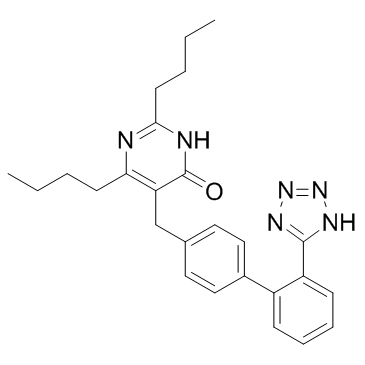| Description |
CGP48369 is a nonpeptidic angiotensin II receptor antagonist, used for anti-hypertensive research.
|
| Related Catalog |
|
| In Vitro |
CGP 48369 binds to the ATl receptor (IC50 1.8 nM in vascular smooth musc1e cells, VSMC) and inhibits AII-induced contraction in rabbit aorta (IC50 8.7 nM)[1].
|
| In Vivo |
CGP48369 (10 mg/kg/day p.o.) decreases BP in two-kidney/one-clip renal hypertensive rats for at least 24 h. In arteries with endothelium, contractions induced by AII 3×10-8 M do not differ in untreated spontaneously hypertensive rats (SHR) and WKY. All evoked significantly smaller contractions in SHR treated with CGP 48369 than in the other treated SHR. Antihypertensive treatment with benazepril or nifedipine, and to a lesser extent with CGP 48369, increases the sensitivity (pD2-va1ue) to intraluminal ACh. In arteries without endothelium, sensitivity to NE is identical in all groups, whereas maximal response in CGP 48369-treated SHR and in nifedipine treated SHR is slightly greater as compared with that in WKY[1]. In SHR, antihypertensive therapy with either benazepril HCl, CGP 48369, valsartan, or nifedipine (each 10 mg/kg/d for 8 weeks) significantly increase endothelium-dependent relaxations evoked by acetylcholine[2].
|
| Animal Admin |
Male Wistar-Kyoto rats (WKY) and SHR aged 7 weeks are used in the assay. All rats are maintained on standard chow with free access to drinking water and used for experiments at age 15 weeks. SHR are randomly assigned 4 groups: All 4 groups are gavaged; in 3 of the 4, either CGP 48369, benazepril, or nifedipine (all 10 mg/kg/day p.o.) is administered for 8 weeks until the day ofthe experiment (age 15 weeks). All drugs are administered only once a day. Rats are studied in randomized order in a single-blinded design. BP is measured by the tail-cuff method 18-20 h after the last administration. Body weight and heart rate (HR) do not differ at the end of the treatment period in the four groups. On the day of the experiment, rats are anesthetized with pentobarbital (40 mg/kg intraperitoneally, i.p.) and the mesenterium is removed and placed in cold (40°C) Krebs-Ringer bicarbonate solution (in mM): NaCl 118.6, KCl 4.8, CaCl2 2.5, MgS04 1.2, KH2P04 1.2, NaHC03 25.1, edetate calcium disodium 0.026, glucose 10.1 (Krebs solution).
|
| References |
[1]. Dohi Y, et al. Angiotensin blockade or calcium antagonists improve endothelial dysfunction in hypertension: studies in perfused mesenteric resistance arteries. J Cardiovasc Pharmacol. 1994 Sep;24(3):372-9. [2]. Tschudi MR, et al. Antihypertensive therapy augments endothelium-dependent relaxations in coronary arteries of spontaneously hypertensive rats. Circulation. 1994 May;89(5):2212-8.
|
